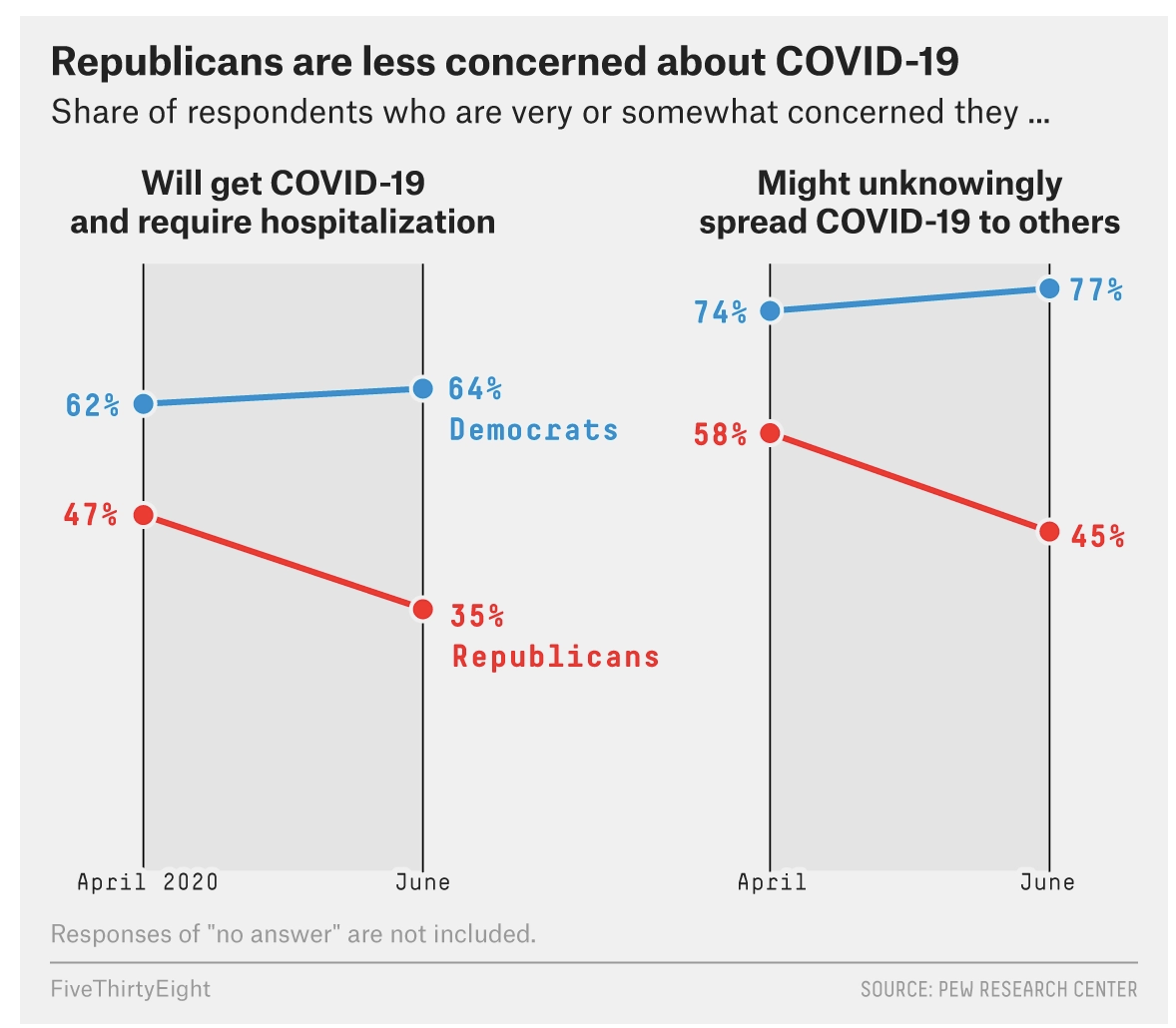A Tale of Two Pandemics: The end of coronavirus (part 2)

Source: FiveThirtyEight https://fivethirtyeight.com/features/republicans-and-democrats-see-covid-19-very-differently-is-that-making-people-sick/
A Tale of Two Pandemics (part 2 of 2; link to part 1) The “two pandemics” are diverging. This has practical consequences for imagining how and when the coronavirus pandemic will end.
What is “The End”?
Much depends, of course, on what you mean by “end.”
The SARS-CoV-2 coronavirus will not go away. That’s the scientific consensus at this point. Over time COVID-19 (the disease) will decrease in incidence, and possibly decrease in average severity too. Mortality will decline as medical care improves. A vaccine(s) would accelerate these trends. But the virus itself is probably here to stay. Four human coronaviruses already are endemic globally and account for 10% to 30% of upper respiratory tract infections in adults (source). SARS-CoV-2 likely will become a fifth because it’s quite contagious; infection is frequently asymptomatic or mild; and immunity against it is not lifelong.
So how will we know the pandemic is “over”? What measure should we use, and who gets to decide?
Ah, another question to be informed by science but decided by values.
One could use any number of arbitrary thresholds to define victory over the virus, or the end of the pandemic. No resolution will be permanent, however, until a suitable fraction of humankind has some degree of protective immunity against the virus. (How big a fraction? Topic for another post.) For example, the pandemic “ended” in New Zealand. The country had an unambiguous victory with its elimination strategy: zero cases of community transmission for a hundred days. Daily life had returned to normal, except for international travel restrictions. Then in August a cluster of new cases of unknown origin popped up. (New Zealand chose to reimpose a strict lockdown in Auckland, along with contact tracing, testing, and isolation. The rest of the country had to resume “level 2” precautions.) For New Zealand, even eliminating the virus from the country was not The End. (Because of their strategy of elimination, NZ’s end is completely dependent on development of an effective vaccine.)
For countries that chose a mitigation strategy instead, it’s even harder to define “the end” of the pandemic. Is it when all their citizens have been fully immunized with an effective vaccine? That’s never gonna happen. When there is no community transmission of the virus? Also probably not gonna happen. What level of transmission equals The End? A definition I like is the pandemic is over when we can gather in large groups—indoors—and almost no one gets sick even if the virus was in the room. But what is the quantitative definition of “almost no one” and out of how many? Should it be “no one”? Who decides?
From a certain point of view, then, the COVID pandemic is over when we say it is. It’s a social choice as much as a medical/technical question.
The end of the fear, on the other hand, is even harder to define or measure. Our fear (or if you prefer, our caution level) is driven by storytelling and personal experience, not data. It’s a question of at what point do we feel safe, regardless of whether that feeling is accurate or not.
As much as a feeling of safety, fatigue defeats fear. We can’t maintain the level of panic that many of us felt back in March. The shock is over. We have a better sense of what to expect with this virus. Implementing various non-pharmaceutical interventions gives us a sense of control—really important for managing fear. The biology of the virus is less uncertain. Identifying risk factors and the importance of age in risk of dying helps us predict our personal vulnerability. The mortality rate is improving. Two million American COVID deaths is no longer on the table.
On the other side of the balance, pandemic restrictions on our social and economic lives are starting to weigh much heavier.
This weariness is what will “end” the pandemic state in our society. The virus will still be out there—forever, basically—but we will gradually stop making accommodations for it.
The End is Near?
This is going to happen whether we consciously choose it or not, whether our leaders advocate for it or not, whether it’s scientifically justified or not. Fundamental human nature is at work. People need and want to be together. This virus is not scary enough to sustain the fear of pandemic much longer. Will the timing be right, and the “two pandemics” wind down together? Maybe, maybe not—but nobody can control it.
I predict the end of the viral pandemic will lag behind the end of the fear of the pandemic. To put this in plain words, a lot of Americans are already “over it” with corona, even though the virus is still a threat. The number of such people is growing every day. It won’t be everyone, of course. But collectively, gradually, the motivation to upend our lives for safety’s sake is eroding.
Our behavior will reflect that. The impacts of the virus itself will continue at some level, but the impacts of our response to the virus will diminish.
Without going into the reasons, I’m making a concrete projection: The fear of pandemic will largely be over at Christmas. I think most Americans will treat this holiday season very, very differently than they treated Easter back in April. Not “normal,” but a lot closer to it.
Does that mean we’ll ring in 2021 with a big disease spike? Maybe not. I actually have a lot of fact-based optimism in my heart right now. In my next blog posts, I’ll talk about immunizations and immunity, and why the next six months might be better than you think.
Amy Rogers, MD, PhD, is a Harvard-educated scientist, novelist, journalist, and educator. Learn more about Amy’s science thriller novels, or download a free ebook on the scientific backstory of SARS-CoV-2 and emerging infections, at AmyRogers.com.
Sign up for my email list
Share this:



0 Comments